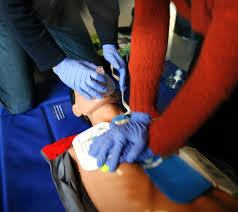
* Check for a heartbeat by looking at the dogs chest to see if its moving or by placing your ear against the dogs chest to listen for a heartbeat. A dogs heart is located where the left elbow touches the chest. To determine if the dog is breathing, place your hand in front of his nose. If the dog is unresponsive, move on to the next step.
* Check that the dogs airway is clear, then pull his tongue forward out of his mouth. (Be careful not to get bitten; even unresponsive dogs may still bite instinctively.) Gently try to bring his head in line with his neck to open the airway.
* Breathe into the dogs nose and watch for his chest to expand. Give just enough air to cause his chest to rise. Large dogs require more air while small dogs require less. Continue breathing into his nose, giving one breath every three seconds.
* If the dogs chest does not rise when you breathe, look into his mouth again for any objects that could be blocking the way. Perform the Heimlich maneuver if necessary by turning the dog upside down with his back against your chest. Use both arms to give five strong, sharp hugs to the abdomen until the object is expelled. If you can see the object, reach in and remove it. Do not begin chest compressions until the airway is clear.
* To start compressions, turn the dog gently onto his right side. Place the heel of your hand on the chest over the heart. Place the other hand palm down on the top. Compress the chest 15 times (about three compressions every two seconds.) Press down about 1 inch for medium sized dogs; press harder for larger animals and more gently for smaller dogs. Be mindful that the dogs ribs could be broken, so dont press too hard. Alternate compressions and breathing two breaths after every 15 compressions.
* Continue CPR until the dog has a heartbeat and is breathing regularly. Take the dog to your veterinarian as soon as he is stable. If you perform CPR and determine that it is not helping, get the dog to an emergency animal hospital immediately.




